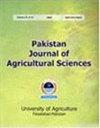Productive performance and serum cortisol level of Sahiwal cows under different housing systems during Winter season
IF 0.6
4区 农林科学
Q3 AGRICULTURE, MULTIDISCIPLINARY
引用次数: 0
Abstract
During winter season, when the environmental temperature goes below the thermoneutral zone, it affects the performance of dairy cows. The objective of current study was to evaluate the influence of various types of housing systems on productive and physiological performance of Sahiwal cows in winter season. For this purpose, Twelve Sahiwal cows almost same weight (363±5kg), milk yield (6±0.5Lday-1 ) and 2nd parity (mid-lactation) were assigned to three experimental groups with four cows in each group. These groups are specified as; conventional barn (CB), open shed+curtain (O+C) and open shed (O) reared cows. Temperature-humidity index values were 63.8, 61.1 and 57.9 in CB, O+C and O groups respectively. Results showed that various types of housing systems had a significant effect on the performance of Sahiwal cows. The intake of dry matter was significantly higher in O reared cows (11.2 kg day-1 ) followed by the O+C (10.3 kg day-1 ) and CB reared cows (10.2 kg day-1 ). The intake of water was maximum in CB reared cows (17.7 L day-1 ) and was minimum in open shed reared O reared cows(14.4 L day-1 ) cows. Similarly, milk yield was maximum in CB readed cows (7.8 L day-1 ) and was minimum in O reared cows(5.2 L day-1 ) cows. No differences were observed in the composition of milk in CB, O+C and O reared cows. The rectal temperature (101.6 °F) was significantly lower in O reared cows followed by O+C and CB reared cows. Similarly, respiration rate was also lower (17.06 breaths min-1 ) in O reared cows followed by O+C and CB reared cows. Serum cortisol levels were significantly higher (21.1 ng/ml) in O reared cows as compared to other dietary treatments. It was concluded that production performance and physiological norms of indigenous Sahiwal cows can be improved by keeping them in conventional closed barn during the winter season.萨希瓦尔奶牛冬季不同饲养制度下的生产性能和血清皮质醇水平
在冬季,当环境温度低于中性温区时,会影响奶牛的生产性能。本研究的目的是评估不同类型的饲养系统对萨希瓦尔奶牛冬季生产和生理性能的影响。为此,将12头体重(363±5kg)、产奶量(6±0.5Lday-1)和第二产(泌乳中期)几乎相同的Sahiwal奶牛分为三个实验组,每组4头。这些组被指定为;常规牛棚(CB)、开放式棚+幕(O+C)和开放式棚(O)饲养的奶牛。CB组、O+C组和O组的温湿度指数分别为63.8、61.1和57.9。结果表明,不同类型的饲养系统对萨希瓦尔奶牛的生产性能有显著影响。O饲养的奶牛(第1天11.2公斤)的干物质摄入量显著较高,其次是O+C(第1天达10.3公斤)和CB饲养的奶牛,第1天达10.2公斤。CB饲养的奶牛的饮水量最大(17.7升,第1天),而开放棚饲养的O饲养的奶牛(14.4升,第2天)的饮水量最小。同样,CB饲养的奶牛产奶量最高(7.8升,第1天),O饲养的奶牛最低(5.2升,第2天)。CB、O+C和O饲养的奶牛的乳汁成分没有观察到差异。O饲养的奶牛的直肠温度(101.6°F)明显较低,其次是O+C和CB饲养的奶牛。同样,O饲养的奶牛的呼吸频率也较低(17.06次呼吸min-1),其次是O+C和CB饲养的奶牛。与其他饮食处理相比,O饲养的奶牛的血清皮质醇水平显著较高(21.1ng/ml)。结果表明,在冬季将土著萨希瓦尔奶牛饲养在传统的封闭式畜棚中,可以提高它们的生产性能和生理指标。
本文章由计算机程序翻译,如有差异,请以英文原文为准。
求助全文
约1分钟内获得全文
求助全文
来源期刊

Pakistan Journal of Agricultural Sciences
AGRICULTURE, MULTIDISCIPLINARY-
CiteScore
1.80
自引率
25.00%
发文量
18
审稿时长
6-12 weeks
期刊介绍:
Pakistan Journal of Agricultural Sciences is published in English four times a year. The journal publishes original articles on all aspects of agriculture and allied fields.
 求助内容:
求助内容: 应助结果提醒方式:
应助结果提醒方式:


